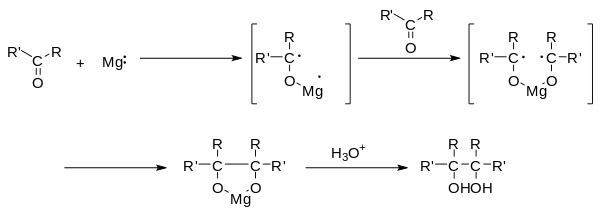A pinacol coupling reaction is an organic reaction in which a carbon–carbon bond is formed between the carbonyl groups of an aldehyde or a ketone in presence of an electron donor in a free radical process.[1] The reaction product is a vicinal diol. The reaction is named after pinacol (also known as 2,3-dimethyl-2,3-butanediol or tetramethylethylene glycol), which is the product of this reaction when done with acetone as reagent. The reaction is usually a homocoupling but intramolecular cross-coupling reactions are also possible. Pinacol was discovered by Wilhelm Rudolph Fittig in 1859.
Reaction mechanism
The first step in the reaction mechanism is one-electron reduction of the carbonyl group by a reducing agent such as magnesium to a ketyl radical anion species. Two ketyl groups react in a coupling reaction yielding a vicinal diol with both hydroxyl groups deprotonated. Addition of water or another proton donor gives the diol. With magnesium as an electron donor, the initial reaction product is a 5-membered cyclic compound with the two oxygen atoms coordinated to the oxidized Mg2+ ion. This complex is also broken up by addition of water with formation of magnesium hydroxide. The pinacol coupling can be followed up by a pinacol rearrangement. A related reaction is the McMurry reaction, which uses titanium(III) chloride or titanium(IV) chloride in conjunction with a reducing agent for the formation of the metal-diol complex, and which takes place with an additional deoxygenation reaction step in order to provide an alkene product.
Scope
Benzaldehyde may undergo the pinacol coupling photochemically,[2] or with the use of catalytic vanadium(III) chloride and aluminium metal as the stoichiometric reductant.[3] This heterogeneous reaction in water at room temperature yields 72% after 3 days with 56:44 dl:meso composition.
In another system with benzaldehyde, Montmorillonite K-10 and zinc chloride in aqueous THF under ultrasound the reaction time is reduced to 3 hours (composition 55:45).[4] On the other hand, certain tartaric acid derivatives can be obtained with high diastereoselectivity in a system of samarium(II) iodide and HMPA.[5]
Two examples of pinacol coupling used in total synthesis are the Mukaiyama Taxol total synthesis and the Nicolaou Taxol total synthesis.
p-Hydroxypropiophenone is used as the substrate in the synthesis of diethylstilbestrol.
An unsymmetrical pinacol coupling reaction between para-chloro-acetophenone and acetone was employed to give phenaglycodol in a 40% yield.
References
- ^ R. Fittig (1859). "Ueber einige Producte der trockenen Destillation essigsaurer Salze". Justus Liebigs Ann. Chem. 110: 23–45. doi:10.1002/jlac.18591100103.
- ^ W. E. Bachmann (1943). "Benzopinacol". Organic Syntheses.; Collective Volume, 2, p. 71
- ^ Xiaoliang Xu; Toshikazu Hirao (2005). "Vanadium-Catalyzed Pinacol Coupling Reaction in Water". J. Org. Chem. 70 (21): 8594–96. doi:10.1021/jo051213f.
- ^ Zang Hongjun; Li Jitai; Bian Yanjiang; Li Tongshuang (2003). "Pinacolization of aromatic aldehydes using Zn/montmorillonite K10-ZnCl2 in aqueous THF under ultrasound". Chemical Journal on Internet. 5 (1): 8. Archived from the original on 2002-11-21.
- ^ Yong Hae Kim; Sam Min Kim; So Won Youn (2001). "Asymmetric synthesis by stereocontrol". Pure Appl. Chem. 73 (2): 283–286. doi:10.1351/pac200173020283.
Further reading
- Roger Adams; E. W. Adams (1941). "Pinacol Hydrate". Organic Syntheses.; Collective Volume, 1, p. 459

